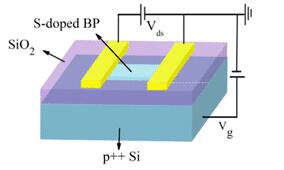A research team led by Prof. ZENG zhongming from Suzhou Institute of Nano-tech and Nano-bionics of the Chinese Academy of Sciences and cooperator Prof. Liu zhongyuan from State Key Laboratory of Metastable Materials Science and Technology of Yanshan University proposed a new strategy to enhanced the stability of black phosphorus by Sulfur doping.
The S-doped BP was prepared by the method of high-pressure and high-temperature. The stability of S-doped BP were investigated by continuously measuring the field-effect transistors (FETs) performances and characterizing the morphology change using atomic force microscope (AFM) under ambient conditions. The charge-carrier mobility remained ~ 77% as the initial value and a high Ion/Ioff ratio of ~103 under ambient for 21 days. The surface morphology variation confirmed that the degradation of S-doped BP was effectively suppressed.
The first-principles calculations reveals that the dopant S atom energetically prefers to chemisorb on the BP surface in a dangling form. The conduction band minimum (CBM) of S-doped BP with respect to vacuum energy shift below the redox potential of O2/O2-. This can effectively suppress the oxidation process of BP.
Their work entitled " Sulfur-doped black phosphorus field-effect transistors with enhanced stability" was published in ACS Applied Materials & Interfaces.
This research was supported by the National Natural Science Foundation of China.

Simulation cell configuration of trilayer S-doped BP.(Image by SINANO)

Schematic of device structure of few-layer S-doped BP FETs.(Image by SINANO)
Contact information:
Prof.ZENG Zhongming, Suzhou institute of Nano-Tech and Nano-Bionics, Chinese Academy of Sciences.
Email: zmzeng2012@sinano.ac.cn

